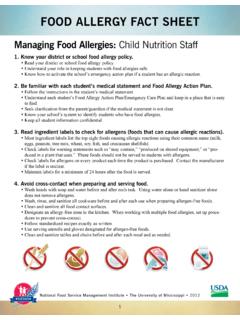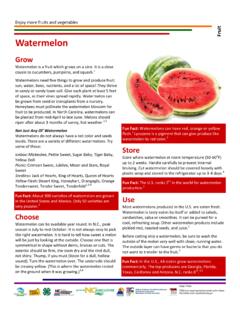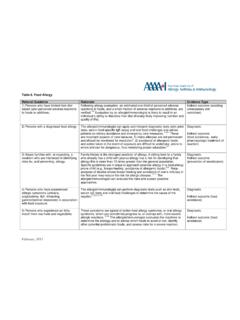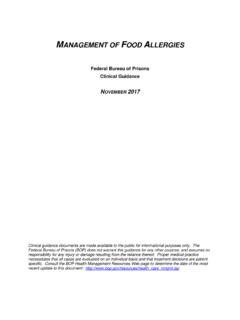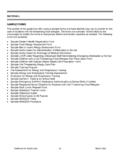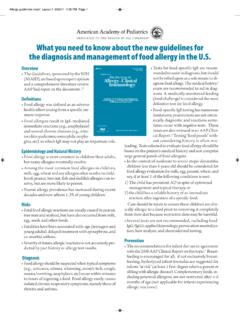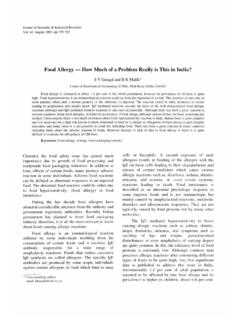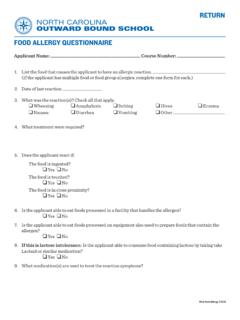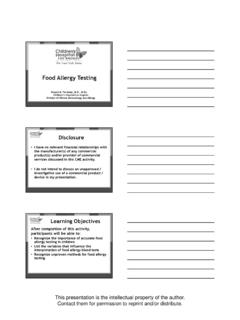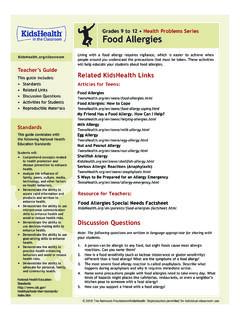Transcription of Food Allergy FAct Sheet - School Nutrition Services
1 food Allergy fact SheetNational food Service Management Institute The University of Mississippi 20121 What nuts should be avoided when a person has a tree nut Allergy ?Typically, individuals with tree nut allergies are not just allergic to one type of tree nut, so physicians recommend avoiding all tree nuts and possibly pea-nuts (even though a peanut is a legume and not a nut). Under law, the following common nuts are considered tree nuts : almonds, Brazil nuts, cashews, chestnuts, filberts, hazelnuts, macadamia nuts, pecans, pine nuts, pistachios, and walnuts.
2 Less common nuts that also fall under this law include beechnut, butter-nut, chinquapin, coconut, ginkgo, hickory, lychee nut, pili nut, and shea nut. Disclosure on food labels of all of these tree nuts is required by law. What are the symptoms?The most common symptoms of an allergic reaction to tree nuts include: Eczema (atopic dermatitis) Hives (urticaria) Asthma Runny nose Digestive symptoms AnaphylaxisTree nuts tend to cause particularly severe allergic reactions, even if very small amounts are consumed.
3 Many people are not aware of previous exposure or allergies to tree nuts when they have their first reac-tion. Tree nut allergies tend to be lifelong; only about 9% of children will outgrow tree nut foods contain tree nuts?There are many unexpected sources of tree nuts, so reading food labels is important to eliminate exposure to tree nuts. Tree nuts are often ingredients in pre-pared products and in ethnic cuisines, such as African, Chinese, Mexican, Thai, and Vietnamese. Natural extracts, such as almond or wintergreen extract, may contain tree nut protein.
4 Tree nuts also can be found in household products, such as lotions and items may not contain tree nuts but may be produced in a facility where tree nuts are used. As a result, cross-contact with tree nuts may occur. Many snack foods may be produced in a facility where many types of snack foods or many different varieties of a product (for example, cereal bars) are produced. Some of the varieties of that product may include tree nuts. A product that is labeled as being produced in a facility with tree nuts should not be consumed by an individual with a tree nut Allergy .
5 Examples of products that might contain tree nuts include: All tree nuts (almonds, beechnuts, Brazil nuts, but-ternuts, cashews, chestnuts, chinquapin, coconuts, filberts, ginkgo, hazelnuts, hickory, lychee nuts, macadamia nuts, pecans, pili nuts, pine nuts, pista-chios, shea nuts, and walnuts) Artificial nuts Barbeque sauces Breading for chicken Fish dishes Gianduja (a chocolate-nut mixture)Tree Nut AllergiesFood Allergy fact SheetNational food Service Management Institute The University of Mississippi 20122 Honey Mandelonas (peanuts soaked in almond flavoring) Marzipan/almond paste Meat-free burgers Mortadella Natural nut extracts and flavorings (for example almond, walnut) Nut butters (for example cashew butter) Nut meal Nut meat Nut oils (for example walnut oil or almond oil) Nut paste (for example almond paste)
6 Pancakes, waffles Pasta Pesto Pie crust Praline Salads and salad dressing locating tree Nuts on a food labelFood labels regulated by the food and Drug Administration (FDA) follow the regulations of the food Allergen Labeling and Consumer Protection Act (FALCPA) by listing the top eight allergens on the label in plain language either in the ingredient list or in a contains statement. All FDA-regulated manufactured food products that contain a tree nut as an ingredient are required to list the specific tree nut on the product Nutrition staff should look for the word tree nut or any of the specific tree nuts listed below.
7 Almonds beechnuts butternuts Brazil nuts cashews chestnuts chinquapin coconut filberts ginkgo hazelnuts hickory lychee nuts macadamia nuts pecans pili nuts pine nuts pistachios shea nuts walnuts For example, cereal that contains tree nuts could be labeled in either of the ways shown in the examples below (bold is used for illustrative purposes only):Label 1 Label 2 INGREDIENTS: Whole grain oats (in-cludes oat bran), Sugar, Modified corn starch, Honey, Brown sugar syrup, Salt, Tripotassium phosphate, Canola and/or rice bran oil, Natural almond : AlmondINGREDIENTS: Whole grain oats (in-cludes oat bran), Sugar, Modified corn starch, Honey, Brown sugar syrup, Salt, Tripotassium phosphate, Canola and/or rice bran oil, Natural almond flavor (Almond).
8 Labels should also be checked for warnings such as may contain tree nuts, produced on shared equip-ment with tree nuts, or produced in a plant that uses tree nuts in other products. These foods should be avoided as the product may contain a small amount of tree nuts through Department of Agriculture (USDA)-regulated foods, namely meat, poultry, and egg products are not required to follow FALCPA labeling regulations but may do so voluntarily. Only common or usual names of the ingredients are required to be identified on these labels.
9 All child Nutrition staff should be trained to read product labels and recognize food allergens. Because food labels change from time to time, School Nutrition staff should check labels for tree nut and tree nut in-gredients for every product each time it is purchased. Labels should be maintained for a minimum of 24 hours for every product served to a child with food allergies in case of a reaction. food Allergy fact SheetNational food Service Management Institute The University of Mississippi 20123 What substitutes can be used for tree nuts in student meals?
10 When menu substitutions or accommodations for a student with life threatening food allergies are re-quested, a medical statement from a physician is required. Refer to the manual Accommodating Chil-dren with Special Dietary Needs in the School Nutri-tion Programs: Guidance for School Foodservice Staff on the USDA web site ( ) for information on the required content of the physician s medical statement. Read and follow the statement exactly. If there is uncertainty about the statement or if it does not provide enough information, contact the house-hold or physician (as permitted by the family) for clarification.

